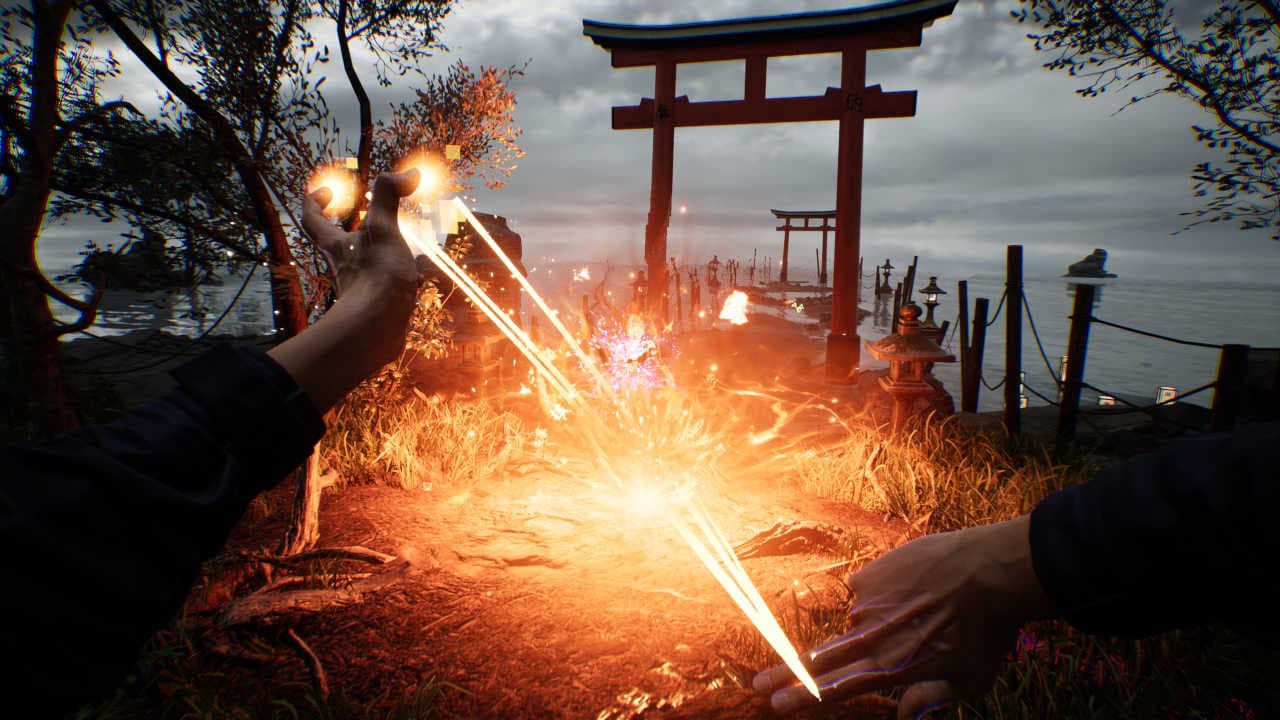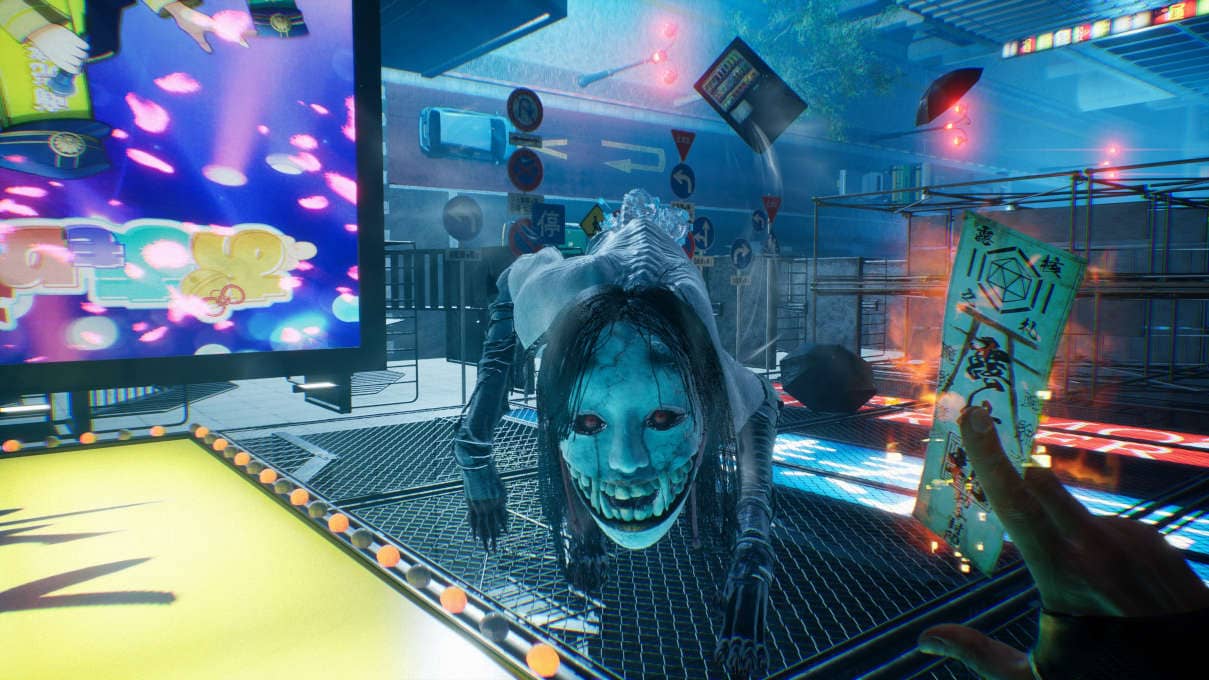Ghostwire: Tokyo preview — spooky shenanigans in Shibuya
The first thing you see in Ghostwire: Tokyo is a beautiful view of the city from above, a small, othering preview of what it feels like to be an outsider looking in.
Then it’s over, and you’re plummeting into the depths of the city in search of a body to inhabit. This is how we’re introduced to KK, a supernatural detective who dives facefirst into the body of our protagonist, Akito – a 22-year-old student who recently got acquainted with the front of a car. Despite waking up from being dead, having supernatural and demonic entities after him, and realizing the majority of Tokyo has disappeared thanks to an unearthly fog, Akito still has enough time to sass about a ghost inhabiting his body. This all happens in the space of the first 5 to 10 minutes of the game. If it sounds a little camp, then let me reassure you by saying you’ve got an excellent eye, because Ghostwire: Tokyo does not shy away from being a little silly, even in its most serious moments.
After the quick introduction between Akito and KK, we’re thrust into the action of having to defend ourselves from Visitors – supernatural beings from the afterlife that have come over to our side due to a man with a Hannya mask for a face. A Hannya mask supposedly represents a “jealous female demon”, which feels fitting considering the masked antagonist’s main beef seems to be with the two worlds of life and the afterlife being separate. There’s a lot of talk about souls and being trapped, as well as Akito’s sister being some sort of catalyst – hence why the first thing you do is go rescue her at a hospital – but the speed in which the game moves you from A to B often leaves you with more questions than answers.
Even so, my 10 hours with Ghostwire: Tokyo (where I’m still on Chapter 2, by the way) has me intrigued to play more. One of the things I’m loving more than anything is the sound design, right from the jaunty, popular pop songs you can find in the small convenience stores, to the shrieks and cackling of the Visitors you fight in Tokyo’s many wards. At one point in the game, I’m underground Shibuya Station looking for someone, with almost no light but a torch and the threatening click-clack of a Visitor’s broken bones moving around somewhere in the darkness. It is chilling and there were more than a couple of times where I had to take my headset off, just to see if that creak of the door was in-game or not.
During my first preview of the game, a developer answered a question on whether the game is ‘scary’ or not by saying it was more of an action-adventure game, but during my 10 hours with Akito and KK, I can no longer count on my hands and toes how many times I’ve jumped or felt scared. So, if you’re into being scared, then congratulations because this game is going to creep. you. out.
Unlike your average horror game, however, you do have the tools to fight back against the various Visitors plaguing the streets of Tokyo. While I’ve only had a small preview of the Ghostwire: Tokyo combat and abilities, what I’ve unlocked and seen for myself has been very promising. As you level up and grow stronger, you’ll be able to pick and choose which abilities you want and upgrade depending on your playstyle. I went for a more stealthy approach in my playthrough, so I focused on abilities that would make me move faster while crouched, as well as upgrade my spiritual vision so I could spot and track enemies at a further distance. Other abilities and upgrades looked at Akito’s Weaving, a technique that calls upon elemental essences like wind, fire, and water to use against and purge Visitors once hit enough times – conveyed through the ripping and tearing of the Visitor’s clothes to the point that a white, core would be revealed. Once that core is seen, Akito can purge the Visitor for good and end combat.

There are other ways to defeat Visitors outside of martial combat, such as through the use of a bow and arrow players get early on in Chapter 1, as well as Talismans which can damage Visitors over time, or stop them in their tracks. Because there are so many different ways to eradicate these demonic entities, it makes sense there are a variety of different styles of Visitors for you to go up against and stragetize . Headless school girls, slender men in business suits with blank faces, a smiling, tall woman dressed all in white, and even slovenly businessmen – just to name a few. Each Visitor comes with their unique aspect – some can heal other Visitors, others use umbrellas to block your hits, and some even take the form of a ghost child in a yellow raincoat that calls Visitors to them when you go near. Nice IT reference, Tango Gameworks.
But what really has me most excited for Ghostwire: Tokyo, despite only being 10 hours in, is the potential of the city itself. Being only 2 chapters in, I’m not quite sure how much of the city – and its features – I’ve seen in full. I can safely assume it’s not everything, but what I have seen so far has me eager to go into the nooks and crannies of the side streets and alleyways of Tokyo to find out what’s down there. Is it even more of KK’s detective notes? A side quest that’ll let me uncover something new and fascinating about the city? A brand new set of shades? Who knows? Not I!
It also helps that there’s just so much to do. Now, as someone who is not at all too fond of open-world games with so much to do, I’ve been pleasantly surpised by games like Elden Ring which offers nothing but a map and a slight push on where it wants you to go. There are no icons telling you what this icon or that sigil means – it’s just pure exploration for players. Ghostwire: Tokyo does not take that stance, often crowding the map with icons of side quests, shops, gates to cleanse, and the like. It can feel more than a little overwhelming at times, but the frantic, frenzied story makes even the most mundane fetch quests feel like a blessing.
In my preview I’ve only scratched the surface of what Ghostwire: Tokyo has to offer, but there’s definitely a lot more for players to unpack when the game launches on March 25th for the PS4, PS5, and PC.









